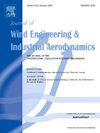Alleviating tunnel aerodynamics through hybrid suction & blowing techniques applied to train nose sections
IF 4.2
2区 工程技术
Q1 ENGINEERING, CIVIL
Journal of Wind Engineering and Industrial Aerodynamics
Pub Date : 2024-11-22
DOI:10.1016/j.jweia.2024.105961
引用次数: 0
Abstract
As high-speed railway lines upgrade speeds or develop ultra-high-speed trains, traditional passive measures may struggle to address tunnel aerodynamics and passenger comfort. This study employs numerical calculations to investigate the aerodynamic mitigation of an ultra-high-speed train traveling at U = 600 km/h through a tunnel, utilizing active suction & blowing techniques in its streamlined nose sections. The simulation employs three-dimensional, compressible, unsteady Reynolds-averaged Navier-Stokes (URANS) methods, validated against full-scale experiments. The effects of slot shapes, suction directions, activation periods, and the suction & blowing velocities (SBv) are examined. Results show that the slit design, normal direction, along with continuous activation, outperforms the rectangular design, parallel direction, and partial activation in reducing pressure peaks. Notably, maximum pressure peaks on the train and tunnel surface exhibit an exponential decay pattern as SBv increases. The micro-pressure wave 20 m from the tunnel exit decreases by 28% as SBv increases from 0 to 0.27U. Additionally, maximum slipstream peaks decrease linearly with SBv, with a more pronounced decline on the near side. While drag on the head and middle cars decreases linearly with increasing SBv, the tail car experiences a quadratic increase in drag, leading to an overall reduction in total drag. Furthermore, the reduction in side force and the positive lift of the tail car enhances train safety during tunnel passage. Overall, the hybrid suction & blowing technique offer promising prospects for enhancing the aerodynamic performance of high-speed maglev trains in the future.
通过应用于列车车头部分的混合吸气和吹气技术缓解隧道空气动力学问题
随着高速铁路线的提速或超高速列车的发展,传统的被动措施可能难以解决隧道空气动力学和乘客舒适度问题。本研究采用数值计算方法,研究了超高速列车以 U = 600 km/h 的速度通过隧道时的空气动力学缓解问题,并在其流线型车头部分采用了主动吸& 吹技术。模拟采用了三维、可压缩、非稳态雷诺平均纳维-斯托克斯(URANS)方法,并与全尺寸实验进行了验证。研究了缝隙形状、吸力方向、激活周期和吸力& 的影响;以及吹气速度 (SBv)。结果表明,在减少压力峰值方面,法线方向的狭缝设计和连续激活优于平行方向的矩形设计和部分激活。值得注意的是,随着 SBv 的增加,列车和隧道表面的最大压力峰值呈现指数衰减模式。当 SBv 从 0 增加到 0.27U 时,距离隧道出口 20 米处的微压力波降低了 28%。此外,最大滑流峰值随 SBv 线性下降,近侧下降更明显。头部和中间车厢的阻力随着 SBv 的增加呈线性下降,而尾部车厢的阻力则呈二次方增加,从而导致总阻力的整体下降。此外,尾部车厢侧向力的减少和正向升力提高了列车通过隧道时的安全性。总之,混合吸& 吹技术为未来提高高速磁悬浮列车的空气动力性能提供了广阔的前景。
本文章由计算机程序翻译,如有差异,请以英文原文为准。
求助全文
约1分钟内获得全文
求助全文
来源期刊
CiteScore
8.90
自引率
22.90%
发文量
306
审稿时长
4.4 months
期刊介绍:
The objective of the journal is to provide a means for the publication and interchange of information, on an international basis, on all those aspects of wind engineering that are included in the activities of the International Association for Wind Engineering http://www.iawe.org/. These are: social and economic impact of wind effects; wind characteristics and structure, local wind environments, wind loads and structural response, diffusion, pollutant dispersion and matter transport, wind effects on building heat loss and ventilation, wind effects on transport systems, aerodynamic aspects of wind energy generation, and codification of wind effects.
Papers on these subjects describing full-scale measurements, wind-tunnel simulation studies, computational or theoretical methods are published, as well as papers dealing with the development of techniques and apparatus for wind engineering experiments.

 求助内容:
求助内容: 应助结果提醒方式:
应助结果提醒方式:


